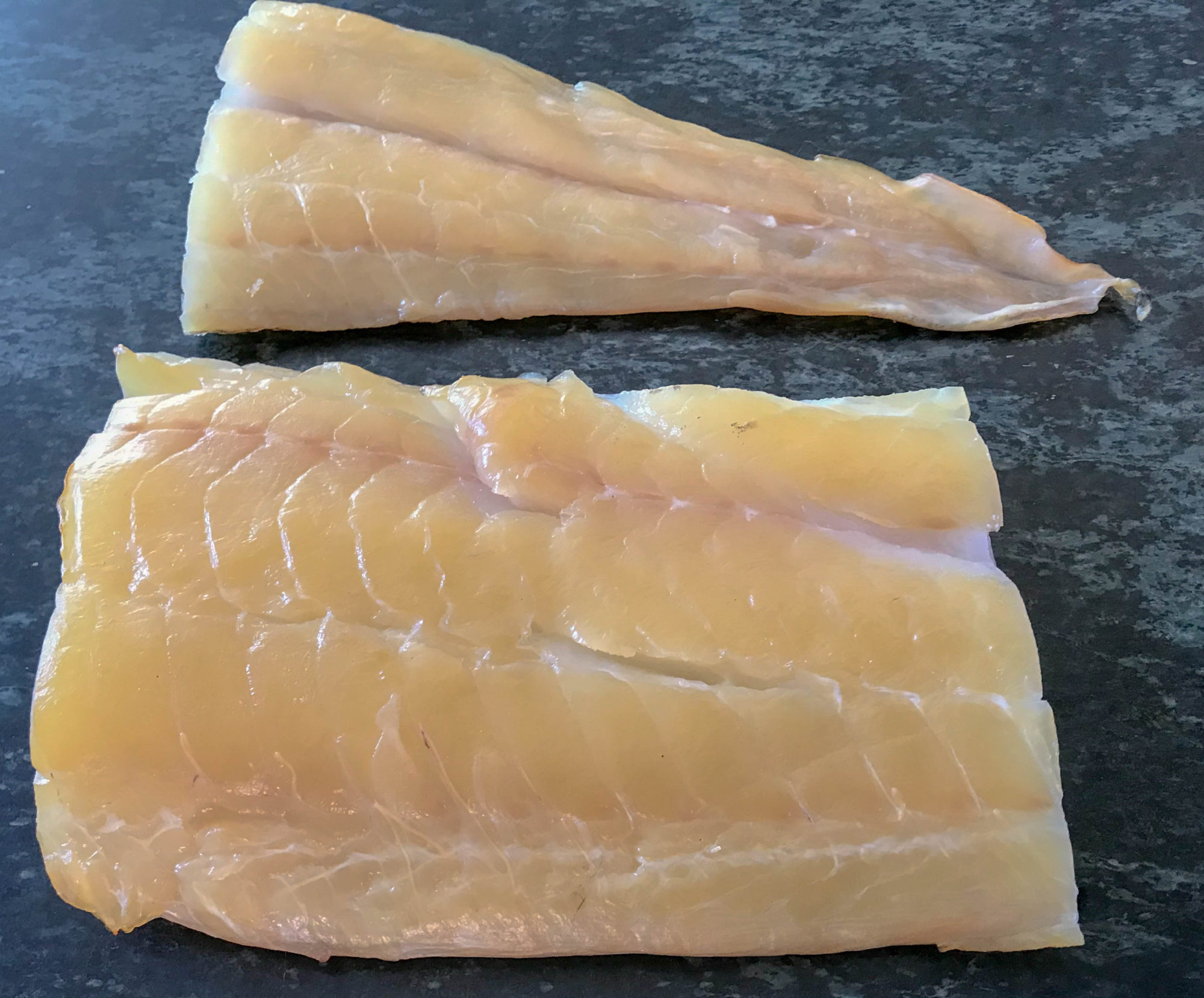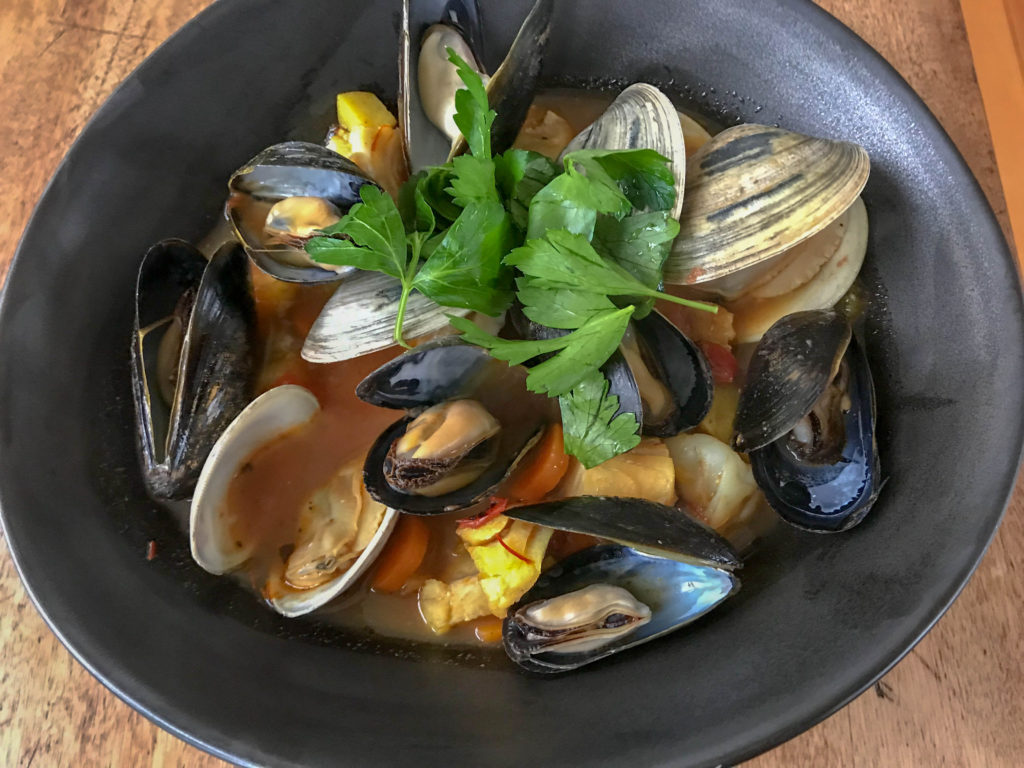A classic cold-smoked product with centuries of Scottish tradition.

I owe much to one of my favorite sites, Serious Eats, for their great recipe for Cullen Skink, a classic, creamy Scottish chowder whose main ingredient is finnan haddie, or cold-smoked haddock. Until I read their recipe, it hadn't sunk in that finnan haddie was a cold-smoked product that I had heretofore ignored, and that I could use their simple brine and my handy trash can smoker to have some ready by dinnertime.
I'll pause here to remind fellow Eaters that it's good practice to weigh the ingredients for brines and similar chemistry-class type recipes, especially due to variations in salt volume among styles and brands. So we'll bow to the natural superiority of the scale and the metric system.
First, make a brine: add the sugar and salt to 500 ml of water in a small saucepan, and heat until it just dissolves. Pour the mixture into a large bowl, add about 500 g of ice to cool things off, and then add another 1000 ml of cold water. Stir or let sit until the ice dissolves.
When the mixture is quite cool - refrigerate if necessary - add the fish. I've sized this recipe for 2 lbs., but 2 liters is plenty of brine for a good 5 lbs of haddock, so if you're an optimist you can go all the way here and freeze what you don't use. Let the fish loll in the brine, in the fridge, for just one hour. Remove and pat dry with paper towels.
Next, let the fish rest, uncovered, on a rack in the fridge for another few hours or overnight. This is just to develop a bit of a sticky skin, or pellicle, that will help the smoke particles stick. Don't omit this step. But - if you are desperate for time, Poppa Larry has found that one hour in front of an ordinary room fan will produce the same result.
You're ready to start smoking! If you're a newbie, keep in mind that cold-smoking is not supposed to cook your fish, just cover it with tiny smoke particles. This is why you can't use an ordinary smoker or BBQ grill, and should only smoke in a temperature range between 25 and 65 degrees F. Much higher and you risk raising the fish temp to over 80 or 85 degrees F, where the proteins can start to link up and turn your nice recipe into haddock jello. You can then either try and create an entire new style of fish cuisine, or just cook it the rest of the way.
So - if you have a patch of backyard or rooftop, follow the trash can link in the directions above to smoke the hell out of that fish. Use oak or cherry if you have it, and smoke for a full 6 hours, with both ends of the A-Maze-N gadget smoldering. For recipes, I can personally recommend the above Cullen Skink, this nice baked potato from the British superstar chef Nigel Slater, or my own lovely Scotch Manhattan Bouillabaisse, pictured below.

Ingredients
Directions
I owe much to one of my favorite sites, Serious Eats, for their great recipe for Cullen Skink, a classic, creamy Scottish chowder whose main ingredient is finnan haddie, or cold-smoked haddock. Until I read their recipe, it hadn't sunk in that finnan haddie was a cold-smoked product that I had heretofore ignored, and that I could use their simple brine and my handy trash can smoker to have some ready by dinnertime.
I'll pause here to remind fellow Eaters that it's good practice to weigh the ingredients for brines and similar chemistry-class type recipes, especially due to variations in salt volume among styles and brands. So we'll bow to the natural superiority of the scale and the metric system.
First, make a brine: add the sugar and salt to 500 ml of water in a small saucepan, and heat until it just dissolves. Pour the mixture into a large bowl, add about 500 g of ice to cool things off, and then add another 1000 ml of cold water. Stir or let sit until the ice dissolves.
When the mixture is quite cool - refrigerate if necessary - add the fish. I've sized this recipe for 2 lbs., but 2 liters is plenty of brine for a good 5 lbs of haddock, so if you're an optimist you can go all the way here and freeze what you don't use. Let the fish loll in the brine, in the fridge, for just one hour. Remove and pat dry with paper towels.
Next, let the fish rest, uncovered, on a rack in the fridge for another few hours or overnight. This is just to develop a bit of a sticky skin, or pellicle, that will help the smoke particles stick. Don't omit this step. But - if you are desperate for time, Poppa Larry has found that one hour in front of an ordinary room fan will produce the same result.
You're ready to start smoking! If you're a newbie, keep in mind that cold-smoking is not supposed to cook your fish, just cover it with tiny smoke particles. This is why you can't use an ordinary smoker or BBQ grill, and should only smoke in a temperature range between 25 and 65 degrees F. Much higher and you risk raising the fish temp to over 80 or 85 degrees F, where the proteins can start to link up and turn your nice recipe into haddock jello. You can then either try and create an entire new style of fish cuisine, or just cook it the rest of the way.
So - if you have a patch of backyard or rooftop, follow the trash can link in the directions above to smoke the hell out of that fish. Use oak or cherry if you have it, and smoke for a full 6 hours, with both ends of the A-Maze-N gadget smoldering. For recipes, I can personally recommend the above Cullen Skink, this nice baked potato from the British superstar chef Nigel Slater, or my own lovely Scotch Manhattan Bouillabaisse, pictured below.


This is going to give someone food poisoning. There is too little salt for proper curing, and brining for just one hour is idiotic. Use a cup of salt and a half cup of sugar for a half gallon of water. Brine for 24 hours. Rinse and let dry until sticky to touch.
Traditional brining and smoking is done as a means of preservation, and the salt curing renders the raw fish safe to eat. This recipe (a tiny amount of salt for a very short time) seems appropriate for something you are going to flavor with smoke and then cook with heat almost immediately.
Very true, PW! This is essentially raw fish. It is meant to be refrigerated or frozen until cooked. The brine is seasoning, but that and the smoking process itself, whether or not you use a trash can, does help preserve the fish for the few hours it might spend above 40 degrees fahrenheit. The result is quite a bit more tender than the traditional product, and it makes a delicious chowder, as pictured. Sorry if all that wasn’t clear! I really appreciate that you visited the site and thought to post a comment.
I ate quite a bit of cold smoked haddock when I was in school. At the time, it was dirt cheap at the fish market. Even though what I got was more heavily salted, I always poached it for dinner.
My son and I have gotten in to smoking fish, mostly salmon. From Oct to May, we get to do cold smoking, hot smoking over the summer months. I am not sure about what role the (cold) smoking plays in preservation. I always thought the salt cure “cooked” all the proteins, and the smoking repelled flies.
You have my respect, sir. Cold smoke in the winter, hot in the summer! There’s actually a lot happening in the brining and smoking process. The protein untangles a bit in the brine, though it doesn’t actually cook in the way that the acid in lime juice will cook ceviche. But just making it saltier inhibits many noxious molds. And the smoke has some direct preservatives, including, FBOW, a little formaldehyde. But really this is about flavoring. I just really like to plump the fish in the brine. An hour is plenty, and won’t make it too salty. Then the smoke gives it a lot of flavor, as well as a nice antique patina. I’ll usually do 4 or 5 pounds at a time and then vacuseal and freeze in one pound packages or so to make chowder throughout the winter. I think I have a similar recipe here for kippered salmon (unsmoked, just brined and baked). Thanks again for writing!
I tend to cure my fish between 12-24 hrs, wash off the cure gt the pellicle to form then smoke between 12-24 hrs.
I like to add a few juniper berries to my cure for Salmon. There is no need to add the salt and sugar in water, I place it on direct and it does the appropriate cure.
I visited a smokery on the West Coast of Ireland and the proprietors cure was pure salt for 7 hrs and cold smoke for 7 hrs
Sounds good! In a nutshell a wet brine adds water (to a point) and a dry brine takes it away. The basic thing is how much water/weight you want to pull out. If you weigh the fish first, I think you’ll find you need to pull out at least 10% of the weight to get a lox-like product. The more you pull out (with time, weight, fans, whatever) the more intense the flavor but also the less juicy and silky the result. Commercial fish smokers typically have lots of air flow and not much smoke, but it lets them process much faster. And of course they sell by weight, so they want to keep as much water as they can, within reason. I think most home smokers go for a dryer, smokier and overall more intense product than you can buy, which is part of the fun. Fans are VERY drying. A night uncovered in the fridge gives me about the same pellicle (and less weight loss) than an hour in front of an ordinary portable room fan!
The salvation for us cold smokers is the tube pellet smoker. https://www.amazon.com/s?k=smoke+tube+for+pellet+smoker&crid=29EX72ZXPYJWY&sprefix=tube+smoker%2Caps%2C112&ref=nb_sb_ss_ts-doa-p_3_11 I feed mine with cherry pellets and do it in my gas BBQ grill. Oct-May in Upstate NY the temp stays below 70°F.
BTW, I always add a half tsp of Pink Salt to the brine. It adds some safety and some texture, and, for salmon, colour.
Agreed on all counts, I have the very similar A-Maze-N smoker, FWIW. Cherry is a nice wood for smoking fish and gives it a bit more color, I normally use either that or apple, which is a little sweeter. This is great smoking weather right now, in Massachusetts, and I am doing arctic char at least every other weekend, the size is perfect for the two of us. I don’t use pink salt myself on cold-smoked fish but I take your point. Maybe I should try it, but I figure I get enough nitrates, between bacon and celery! It does give fish a kind of indefinable heft or unity of flesh, if you will; not quite the same as firmness.